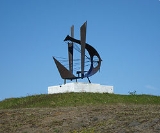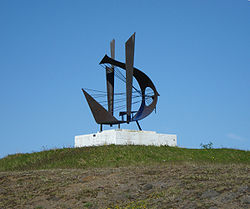
Art of Iceland
Encyclopedia

Iceland
Iceland , described as the Republic of Iceland, is a Nordic and European island country in the North Atlantic Ocean, on the Mid-Atlantic Ridge. Iceland also refers to the main island of the country, which contains almost all the population and almost all the land area. The country has a population...
ic art has been built on northern European traditions
Western painting
The history of Western painting represents a continuous, though disrupted, tradition from antiquity. Until the mid-19th century it was primarily concerned with representational and Classical modes of production, after which time more modern, abstract and conceptual forms gained favor.Developments...
of the nineteenth century, but developed in distinct directions in the twentieth century, influenced in particular by the unique Icelandic landscape
Geography of Iceland
Iceland is a medium-sized island in the North Atlantic ocean. The island is located east of Greenland and immediately south of the Arctic Circle, atop the divergent boundary of the Mid-Atlantic Ridge in the North Atlantic Ocean. It lies about from New York City and from Scotland...
as well as by Icelandic mythology and culture
Culture of Iceland
The culture of Iceland is rich and varied as well as being known for its literary heritage which stems from authors from the 12th to 14th centuries. Other Icelandic traditional arts include weaving, silversmithing, and wood carving. The Reykjavík area has several professional theatres, a symphony...
.
Origins of contemporary Icelandic visual art

Copenhagen
Copenhagen is the capital and largest city of Denmark, with an urban population of 1,199,224 and a metropolitan population of 1,930,260 . With the completion of the transnational Øresund Bridge in 2000, Copenhagen has become the centre of the increasingly integrating Øresund Region...
, returned to Iceland to paint and exhibit works from 1900 to his death in 1924, almost exclusively portraying the Icelandic landscape. Þorláksson was not the only Icelandic artist learning in Denmark at that time: there were several Icelanders, both men and women, at the Academy in the closing years of the century, and these included Ásgrímur Jónsson
Ásgrímur Jónsson
Ásgrímur Jónsson was an Icelandic painter, and one of the first in the country to make art a professional living. He studied at the Royal Academy in Copenhagen between 1900-1903 and traveled widely after graduation....
, who together with Þorláksson created a distinctive portrayal of their home country's landscape in a romantic naturalistic style.
Landscape painting
The distinctive rendition of the Icelandic landscape by its painters can be linked to nationalism and the movement toward home rule and independence, which was very active in this period. Other landscape artists quickly followed in the footsteps of Þorláksson and Jónsson. These included Jóhannes KjarvalJóhannes Sveinsson Kjarval
Jóhannes Sveinsson Kjarval was an Icelandic painter. He is one of the most famous artists of Iceland.The paintings of Kjarval vary greatly in style. Most of them are rather realistic presentations of the Icelandic landscape whereas others are more influenced by a somewhat mythical style...
, Jón Stefánsson, and Júlíana Sveinsdóttir
Júlíana Sveinsdóttir
Júlíana Sveinsdóttir was one of Iceland's first woman painters and textile artists. Taught initially by prominent Icelandic artist Þórarinn B...
. Kjarval in particular is noted for the distinct techniques in the application of paint that he developed in a concerted effort to render the characteristic volcanic rock
Volcanic rock
Volcanic rock is a rock formed from magma erupted from a volcano. In other words, it is an igneous rock of volcanic origin...
that dominates the Icelandic environment.
The emergence of abstract art
Abstract artAbstract art
Abstract art uses a visual language of form, color and line to create a composition which may exist with a degree of independence from visual references in the world. Western art had been, from the Renaissance up to the middle of the 19th century, underpinned by the logic of perspective and an...
became prominent in Iceland in the mid-twentieth century, spearheaded by artists such as Svavar Guðnason
Svavar Guðnason
Svavar Guðnason was an Icelandic painter.-Bibliography:*...
and Nína Tryggvadóttir
Nína Tryggvadóttir
Nína Tryggvadóttir was born Jónína Tryggvadóttir in Seyðisfjörður, Iceland.Nína Tryggvadóttir is one of Iceland's most important abstract expressionist artists and one of very few Icelandic female artists of her generation. Mainly working in painting she also did paper collage, stained glass work,...
. However some of the country's prominent artists working in that period eschewed abstractionism, such as Gunnlaugur Scheving
Gunnlaugur Scheving
Gunnlaugur Scheving was an Icelandic painter.-References:...
who instead favoured narrative content and an approach to colour and form possibly influenced by fauvism
Fauvism
Fauvism is the style of les Fauves , a short-lived and loose group of early twentieth-century Modern artists whose works emphasized painterly qualities and strong colour over the representational or realistic values retained by Impressionism...
and cubism
Cubism
Cubism was a 20th century avant-garde art movement, pioneered by Pablo Picasso and Georges Braque, that revolutionized European painting and sculpture, and inspired related movements in music, literature and architecture...
; and Louisa Matthíasdóttir
Louisa Matthíasdóttir
Louisa Matthíasdóttir was an Icelandic-American painter.Matthíasdóttir was born in Reykjavík. She showed artistic ability at an early age, and studied first in Denmark and then under Marcel Gromaire in Paris...
, based in New York, who learned from abstract expressionism
Abstract expressionism
Abstract expressionism was an American post–World War II art movement. It was the first specifically American movement to achieve worldwide influence and put New York City at the center of the western art world, a role formerly filled by Paris...
but nevertheless painted from life.
The return of figurative art
Einar HákonarsonEinar Hákonarson
Einar Hákonarson is one of Iceland's best known artists. He is an expressionistic and figurative painter who brought the figure back into Icelandic painting in 1968. He is a pioneer in the Icelandic art scene and art education...
's show in 1968 distinguished itself from its Icelandic art scene then current as Hákonarson’s paintings were pop
Pop art
Pop art is an art movement that emerged in the mid 1950s in Britain and in the late 1950s in the United States. Pop art challenged tradition by asserting that an artist's use of the mass-produced visual commodities of popular culture is contiguous with the perspective of fine art...
, figurative
Figurative art
Figurative art, sometimes written as figurativism, describes artwork—particularly paintings and sculptures—which are clearly derived from real object sources, and are therefore by definition representational.-Definition:...
and expressionistic. This exhibition brought the figure back into the Icelandic painting, which had been dominated by the abstract art for years. Hakonarson said he was more influenced by feeling for nature, rather than by trying to paint a specific part of it.
Icelandic art from the late twentieth century
The portrayal of the landscape through visual art has remained a prominent (perhaps the most prominent) theme in Icelandic art to the present day, often reflected in the exhibitions at the country's national galleryNational Gallery of Iceland
The National Gallery of Iceland is located in Reykjavík, and contains a collection of Icelandic art. The gallery features artwork of famous Icelandic artists and artwork that helps explain the traditional Icelandic culture.- External links :* including...
. Its 2007 summer exhibition, for example, was called "Alas Nature!" and described as an exhibition which "aims to examine nature in a different light and from a different angle from what is generally accepted". Debate has occurred within the artistic community as to whether an appropriate balance has been struck in the support of galleries and public institutions for different media, traditions and subjects in Icelandic visual art.
Reading
- Ólafur Kvaran (ed.), Þórarinn B. Þorláksson: Pioneer at the Dawn of a Century, Listasafn Íslands, Reykjavík, 2000.
- Ólafur Kvaran and Karla Kristjánsdóttir (eds), Confronting Nature: Icelandic Art of the 20th Century, National Gallery of Iceland, Reykjavík, 2001.
- Hrafnhildur Schram, Dagny Heiddal and Harpa Thórsdóttir, Patterns of Land and Colour: Júlíana Sveinsdóttir, Listasafn Íslands, Reykjavík, 2003.
- Jed Perl (ed.), Louisa Matthiasdottir, Hudson Hills Press, New York, 1999, ISBN 978-1-55595-197-9
External links
- National Gallery of Iceland (Listasafn Íslands)
- Reykjavik Art Museum
- CIA.IS – Center for Icelandic Art
- LIST icelandic art news
See also
- Architecture of IcelandArchitecture of IcelandThe architecture of Iceland draws from Scandinavian influences and, traditionally, was influenced by the lack of native trees on the island. As a result, grass- and turf-covered houses were developed. Later on, the Swiss chalet style became a prevailing influence in Icelandic architecture as many...
- Culture of IcelandCulture of IcelandThe culture of Iceland is rich and varied as well as being known for its literary heritage which stems from authors from the 12th to 14th centuries. Other Icelandic traditional arts include weaving, silversmithing, and wood carving. The Reykjavík area has several professional theatres, a symphony...
- List of Icelandic artists
- Center for Icelandic ArtCenter for Icelandic ArtThe CIA.IS - Center for Icelandic Art is the platform for Icelandic visual art activities. CIA.IS promotes Icelandic art by connecting the local visual art community with the international art network...
- SEQUENCES real-time art festivalSEQUENCES real-time art festivalSEQUENCES Art Festival is held in the capital of Iceland, Reykjavik. Its emphasis is time-based work, performance, sound art, video and music.- Concept :...

